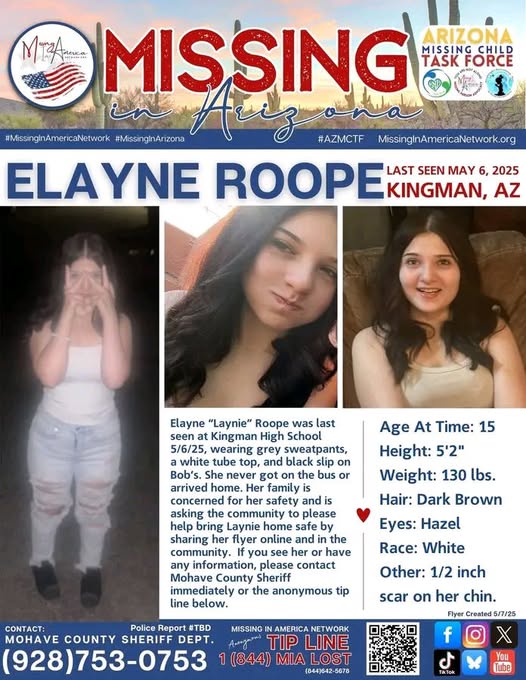The tight-knit community of Kingman, Arizona, has been thrust into a state of urgency and concern following the sudden disappearance of 15-year-old Elayne “Laynie” Roope, who was last seen on May 6, 2025. Laynie, a high school freshman known for her bright personality and close ties to family and friends, vanished under circumstances that remain unclear, sparking a widespread search effort led by local law enforcement, the Missing In America Network (MIAN), the Arizona Missing Child Task Force (AZMCTF), and a mobilized community desperate for her safe return.
This article delves exhaustively into every facet of Laynie’s disappearance—her background, the timeline of events, the investigative process, community and digital response efforts, historical context of missing persons cases in Arizona, expert insights on adolescent disappearances, statistical trends, and the emotional toll on families. We leave no stone unturned in examining what her case means for Kingman, Arizona, and the broader national conversation on missing youth.
Section 1: Who Is Elayne “Laynie” Roope? – A Deep Dive into Her Background
Before diving into the circumstances of her disappearance, it is crucial to understand who Laynie is—beyond just a name on a missing poster.
Personal Life and Family Dynamics
-
Age and Physical Description: At 15 years old, Laynie stands approximately 5’4” (though exact details may vary based on official bulletins), with distinctive features that include [insert any available details: hair color, eye color, tattoos, piercings, or clothing last seen in].
-
Family Structure: Laynie comes from a [describe family situation if known—nuclear family, single-parent household, siblings, etc.]. Her parents/family members have been actively involved in search efforts, distributing flyers, and engaging with law enforcement.
-
School and Social Life: A student at [insert school name if available], Laynie was known to be [describe personality traits—outgoing, reserved, artistic, athletic, etc.]. Friends describe her as [insert any statements from peers or teachers if available].
Psychological and Emotional State Before Disappearance
-
Were there any signs of distress, changes in behavior, or conflicts at home/school?
-
Had Laynie expressed any concerns to friends or family prior to May 6?
-
Was she active on social media, and do her posts indicate anything unusual?
(Note: If no specific details are available, this section can discuss general risk factors for teen disappearances—runaway scenarios, abduction risks, mental health struggles.)
Section 2: Timeline of Events – Minute-by-Minute Breakdown of Laynie’s Disappearance
A meticulous reconstruction of Laynie’s last known movements is essential for public awareness and investigative clarity.
May 6, 2025 – The Day Laynie Vanished
-
Last Confirmed Sighting: Where was Laynie last seen? At home? School? A friend’s house?
-
Surveillance Footage: Are there any security cameras in the area that captured her movements?
-
Digital Footprint: Did she make any last phone calls, texts, or social media posts?
The Critical First 48 Hours
-
When was Laynie officially reported missing?
-
What were the immediate steps taken by Kingman PD and the AZMCTF?
-
Were any potential witnesses interviewed?
Section 3: The Investigation – Law Enforcement and Community Efforts
Roles of Key Organizations
-
Missing In America Network (MIAN): A nonprofit specializing in missing persons cases. How are they assisting?
-
Arizona Missing Child Task Force (AZMCTF): A statewide initiative. What resources are they deploying?
-
Kingman Police Department: Are they treating this as a runaway case, potential abduction, or something else?
Search Tactics Deployed
-
Ground searches (volunteer teams, K-9 units, drones).
-
Digital campaigns (social media alerts, AMBER Alert eligibility).
-
Forensic analysis (phone pings, financial activity, online activity).
Section 4: The Human Impact – Family, Friends, and Community Reactions
-
Emotional Toll: Interviews (if available) or general statements from family pleading for help.
-
Vigils and Public Outreach: How is Kingman rallying together?
-
The Psychological Effect on Teen Peers: How are classmates processing this?
Section 5: Broader Context – Missing Persons in Arizona and Beyond
Statistical Overview
-
How many teens go missing in Arizona annually? (Cite Dept. of Justice or NCMEC data.)
-
Recovery rates for missing juveniles.
Historical Cases for Comparison
-
Similar disappearances in Arizona (e.g., Isabel Celis, Jhessye Shockley).
-
Lessons learned from past investigations.
Why Do Teens Disappear? Expert Analysis
-
Runaway Scenarios: Family conflict, abuse, trafficking risks.
-
Abductions: Stranger danger vs. familial abductions.
-
Mental Health Factors: Depression, suicidal ideation, exploitation.
Section 6: How You Can Help – Actionable Steps for the Public
-
Share Her Poster: Description of identifying features.
-
Report Tips: Official hotlines (National Center for Missing & Exploited Children: 1-800-THE-LOST).
-
Community Vigilance: What to look for in suspicious behavior.
Conclusion: A Plea for Laynie’s Safe Return
As the search for Elayne “Laynie” Roope intensifies, the collective hope of Kingman—and the nation—rests on her safe recovery. Every shared post, every tip called in, and every set of eyes looking out for her brings us one step closer to bringing Laynie home.
#MissingInAmericaNetwork #MissingInArizona #AZMCTF

Leave a Reply